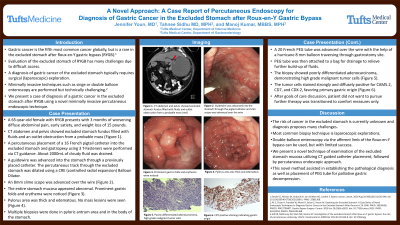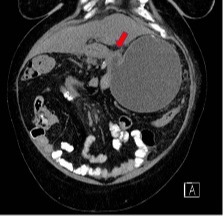Tuesday Poster Session
Category: Interventional Endoscopy
P3737 - A Novel Approach: A Case Report of Percutaneous Endoscopy for Diagnosis of Gastric Cancer in the Excluded Stomach After Roux-en-Y Gastric Bypass
Tuesday, October 24, 2023
10:30 AM - 4:00 PM PT
Location: Exhibit Hall

Has Audio
.jpg)
Jennifer Youn, MD
Tufts Medical Center
Boston, MA
Presenting Author(s)
Jennifer Youn, MD, Tahnee Sidhu, MD, MPH, Manoj Kumar, MBBS, MPH
Tufts Medical Center, Boston, MA
Introduction: Gastric cancer is the fifth most common cancer globally and diagnosed with endoscopic biopsy. Roux-en-Y gastric bypass is a common weight reduction surgery. Evaluation of the excluded stomach has many challenges due to difficult access. Most common biopsy technique is laparoscopic exploration. There are few reports of accessing the excluded stomach using double-balloon enteroscopy via the afferent limb. We present a case of gastric cancer in the excluded stomach after Roux-en-Y gastric bypass surgery diagnosed using a novel percutaneous endoscopic technique.
Case Description/Methods: A 65-year-old female with Roux-En-Y gastric bypass presents with 3 months of abdominal pain, early satiety, and weight loss. Physical exam revealed distended abdomen with umbilical tenderness. Lab findings showed CA-125 177 U/mL and CEA 5.1 ng/mL. CT A/P showed excluded stomach filled with fluid, a pyloric obstruction, and multiple mesenteric lymphadenopathies.
A novel technique to explore the excluded stomach was applied. Using CT guidance, a 16 Fr. pigtail catheter was placed into the excluded stomach percutaneously and gastropexy was performed using 3 T-Fasteners. 2L of fluid was drained. Subsequently, a guidewire was advanced into the stomach through the catheter. Catheter was withdrawn and track was dilated using a 10mm CRE (controlled radial expansion) balloon. Balloon was then exchanged with 8mm ultra slim scope over the wire. The stomach mucosa appeared thick, edematous, and erythematous with changes most prominent in pylorus. Cold forceps biopsies were done and scope was withdrawn. A 20 Fr. PEG tube was then placed to assist continuous decompression of remnant stomach.
The biopsy of pylorus showed poorly differentiated adenocarcinoma, demonstrating high grade malignant tumor cells from primary gastric origin. After the goals of care discussion, patient did not wish to pursue further therapy and was transitioned to comfort care.
Discussion: The risk of cancer in the excluded stomach is currently unknown and diagnosis proposes many challenges. Most common biopsy technique is laparoscopic explorations. Double-balloon enteroscopy via the afferent limb of the Roux-en-Y bypass can be used, but with limited success. We present a novel technique of examination of the excluded stomach mucosa utilizing CT guided catheter placement, followed by percutaneous endoscopic approach. This novel method assisted in establishing the pathological diagnosis as well as placement of PEG tube for palliative gastric decompression.

Disclosures:
Jennifer Youn, MD, Tahnee Sidhu, MD, MPH, Manoj Kumar, MBBS, MPH. P3737 - A Novel Approach: A Case Report of Percutaneous Endoscopy for Diagnosis of Gastric Cancer in the Excluded Stomach After Roux-en-Y Gastric Bypass, ACG 2023 Annual Scientific Meeting Abstracts. Vancouver, BC, Canada: American College of Gastroenterology.
Tufts Medical Center, Boston, MA
Introduction: Gastric cancer is the fifth most common cancer globally and diagnosed with endoscopic biopsy. Roux-en-Y gastric bypass is a common weight reduction surgery. Evaluation of the excluded stomach has many challenges due to difficult access. Most common biopsy technique is laparoscopic exploration. There are few reports of accessing the excluded stomach using double-balloon enteroscopy via the afferent limb. We present a case of gastric cancer in the excluded stomach after Roux-en-Y gastric bypass surgery diagnosed using a novel percutaneous endoscopic technique.
Case Description/Methods: A 65-year-old female with Roux-En-Y gastric bypass presents with 3 months of abdominal pain, early satiety, and weight loss. Physical exam revealed distended abdomen with umbilical tenderness. Lab findings showed CA-125 177 U/mL and CEA 5.1 ng/mL. CT A/P showed excluded stomach filled with fluid, a pyloric obstruction, and multiple mesenteric lymphadenopathies.
A novel technique to explore the excluded stomach was applied. Using CT guidance, a 16 Fr. pigtail catheter was placed into the excluded stomach percutaneously and gastropexy was performed using 3 T-Fasteners. 2L of fluid was drained. Subsequently, a guidewire was advanced into the stomach through the catheter. Catheter was withdrawn and track was dilated using a 10mm CRE (controlled radial expansion) balloon. Balloon was then exchanged with 8mm ultra slim scope over the wire. The stomach mucosa appeared thick, edematous, and erythematous with changes most prominent in pylorus. Cold forceps biopsies were done and scope was withdrawn. A 20 Fr. PEG tube was then placed to assist continuous decompression of remnant stomach.
The biopsy of pylorus showed poorly differentiated adenocarcinoma, demonstrating high grade malignant tumor cells from primary gastric origin. After the goals of care discussion, patient did not wish to pursue further therapy and was transitioned to comfort care.
Discussion: The risk of cancer in the excluded stomach is currently unknown and diagnosis proposes many challenges. Most common biopsy technique is laparoscopic explorations. Double-balloon enteroscopy via the afferent limb of the Roux-en-Y bypass can be used, but with limited success. We present a novel technique of examination of the excluded stomach mucosa utilizing CT guided catheter placement, followed by percutaneous endoscopic approach. This novel method assisted in establishing the pathological diagnosis as well as placement of PEG tube for palliative gastric decompression.

Figure: Figure 1. CT Abdomen and Pelvis with oral contrast showing fluid-filled distention of the excluded stomach with abnormal thickening and circumferential narrowing of the stomach antrum with associated fat stranding, suspicious for outlet obstruction (red arrow)
Disclosures:
Jennifer Youn indicated no relevant financial relationships.
Tahnee Sidhu indicated no relevant financial relationships.
Manoj Kumar indicated no relevant financial relationships.
Jennifer Youn, MD, Tahnee Sidhu, MD, MPH, Manoj Kumar, MBBS, MPH. P3737 - A Novel Approach: A Case Report of Percutaneous Endoscopy for Diagnosis of Gastric Cancer in the Excluded Stomach After Roux-en-Y Gastric Bypass, ACG 2023 Annual Scientific Meeting Abstracts. Vancouver, BC, Canada: American College of Gastroenterology.
